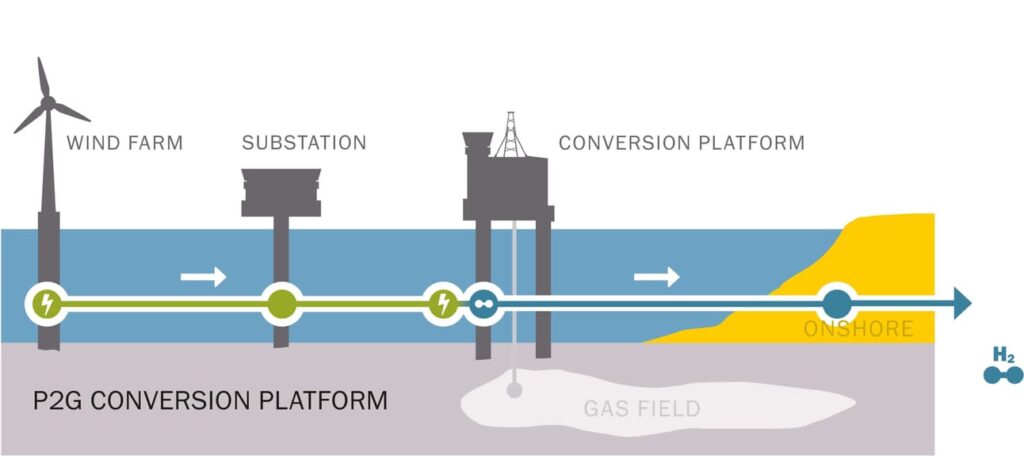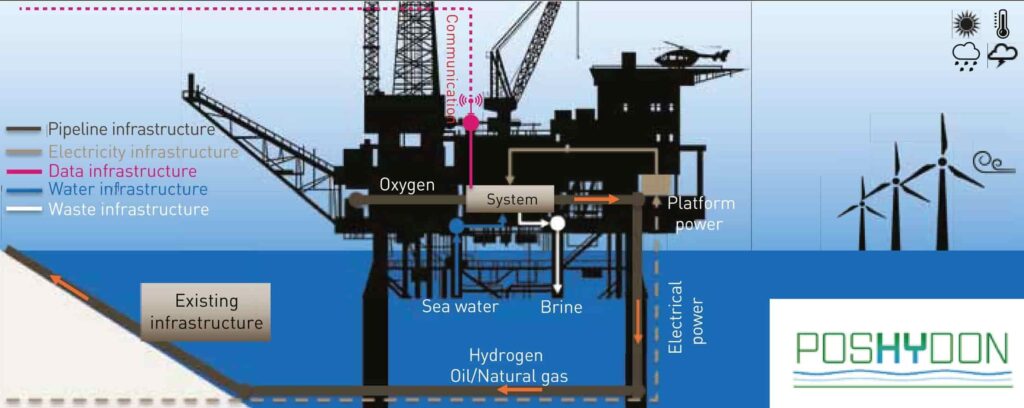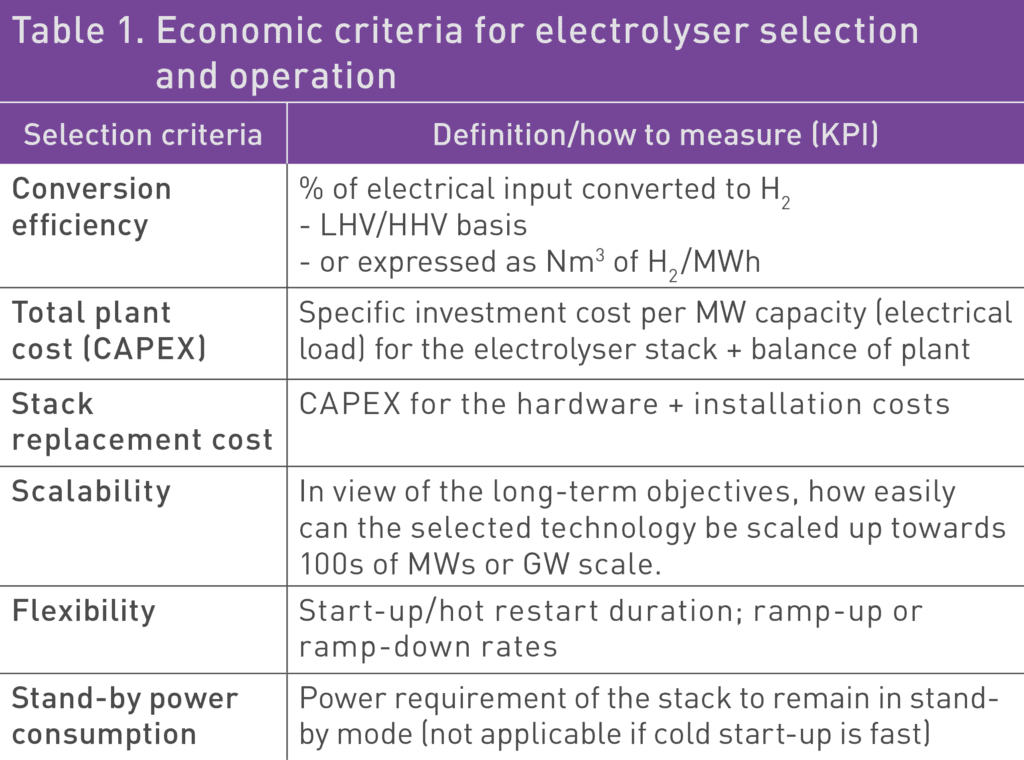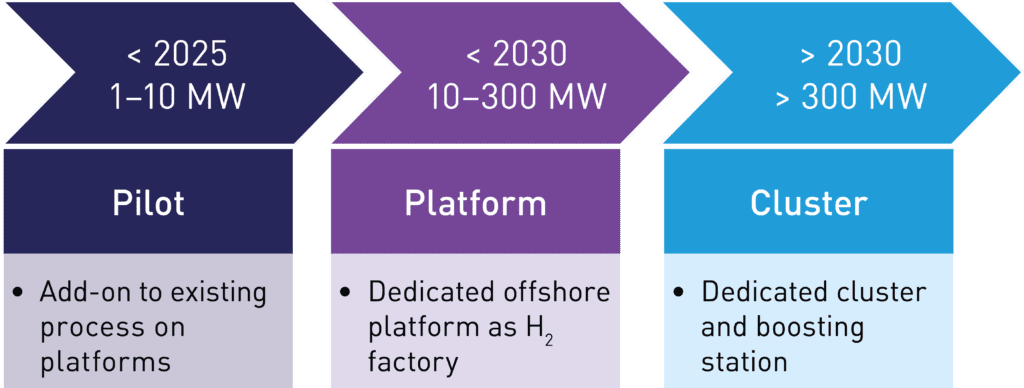By Rene Peters, Business Director Gas Technology, TNO
The accelerated deployment of renewable wind increasingly far offshore creates challenges to the transport of large amounts of energy to shore. Traditional energy transport from offshore wind by means of HVAC power cables becomes uneconomic beyond 100 km from shore, and energy losses are unacceptably high. Moving to HVDC cables reduces the power losses but increases the cost of power conversion offshore. An alternative that is currently being considered is energy transport via molecules, in the form of hydrogen. The hydrogen is produced from seawater after desalination by means of water electrolysis.
The current pipeline infrastructure in the North Sea can partly be reused to transport hydrogen at high pressure and low cost to shore. The capacity of the trunklines in the North Sea, which currently transport natural gas to shore, to carry hydrogen in the future can be up to 15 GW per trunkline, depending on the operating pressure, gas velocity, and pipeline diameter. This makes offshore hydrogen transport an attractive alternative for long-distance transport of offshore wind energy to shore. As large industry sectors are considering decarbonisation by means of hydrogen, particularly for hydrotreatment, desulfurization, steel and ammonia production, the so-called ‘green’ hydrogen can directly be used onshore without reconversion to power. As many industry clusters of Northwest Europe are located near the coast, this makes hydrogen from offshore wind an attractive option for decarbonisation.
Repurposing offshore assets
As many of the assets in the southern North Sea are approaching end of life and will be decommissioned in the coming decade, they become available for repurposing, for example for transport of CO2 or hydrogen. Prior and ongoing research projects are aimed at identifying win-win combinations of repurposing offshore assets: to reuse platforms for hydrogen production via power-to-gas (P2G), pipelines for hydrogen or CO2 transport, and wells for hydrogen or CO2 storage, so that the variable nature of wind power can be exploited more efficiently.
Offshore hydrogen production is currently being developed in various concepts to bring far-offshore or floating wind to shore. The first concept is full integration of the wind turbine and seawater electrolyser to produce pure hydrogen at each turbine. Amongst others, the Dutch turbine manufacturer Hygro and German electrolyser manufacturer Siemens are developing this concept,
which is still in a pilot phase for onshore testing.
Another concept is centralised conversion of offshore wind on an offshore platform, where seawater is desalinated and used to feed the electrolyser that converts offshore wind power into hydrogen, oxygen, and heat. As up to 80% of the power needed for this process is captured in hydrogen, hydrogen is used as a carrier to transport energy via a pipeline to shore. The oxygen and heat are released to the air. This concept is studied in two options: full conversion of offshore wind into hydrogen, or partial conversion of the energy into hydrogen and partially electric power conversion to HVDC for transport. The PosHYdon pilot project is the first demonstration of this concept. In the second option, an HVDC power cable is still required, but the energy transport can be optimised between electrons and molecules, delivering to different energy markets onshore, which offers an opportunity to maximise the value of the wind power and optimise the load factor of the power cable.
A third concept is to concentrate the conversion of wind to hydrogen on energy islands or energy hubs. This allows for a larger scale of conversion that might be needed for future far-offshore wind park development beyond multiple GW scale as well as enables interconnections with neighbouring countries. This concept is being developed by the North Sea Wind Power Hub consortium and will be deployed in the energy island project that has been announced in Denmark.

The concept of offshore P2G utilising an existing oil and gas platform. Wind energy generated in the form of electricity is converted to hydrogen by electrolysis and transported over long distance to shore by pipelines.
PosHYdon project
The PosHYdon project is the world’s first pilot for offshore hydrogen production on an operational oil and gas platform that will bring hydrogen to shore via an existing pipeline, thereby demonstrating the full value chain of wind-to-hydrogen conversion and use. The objective of PosHYdon is not only to gain experience in the production of green hydrogen in an offshore environment, but also to be a test location for innovative P2G technologies and integrated systems. The facility will accommodate 1 MW of electrolyser capacity, including its water treatment unit, power supply, and auxiliary units. A seawater desalinisation unit is also part of the system. The project aims to provide practical experience of operating a hydrogen production unit offshore using seawater and the admixing of hydrogen in a multiphase flow pipeline carrying oil and gas towards a process separation and treatment hub located nearby. Furthermore, the pilot seeks to gain more detailed information on the cost of installation and operation of an electrolyser unit in an offshore environment. Crucially, the pilot should also generate important knowledge about the safety aspects of developing green hydrogen production offshore. The pilot is funded by 14 partners in the project and was awarded the DEI+ subsidy by The Netherlands Enterprise Agency (RVO), part of the Dutch Ministry of Economic Affairs and Climate Policy.

Schematic of the PosHYdon pilot. First, wind energy is delivered to the platform via a power cable, then desalinated seawater is split by an electrolyser to hydrogen and oxygen, and finally, hydrogen is admixed with the natural-gas stream to shore.
Platform and technology selection
To select the candidate platform for the pilot for hydrogen production offshore, the project team proposed technical and economic criteria. The Q13a-A platform of Neptune Energy, approximately 13 kilometres off the coast of Scheveningen (The Hague), was selected to host the pilot as it is currently the only electrified platform in the Dutch offshore sector, has sufficient free deck space and crane capacity to locate the pilot on deck, and is located nearby an existing offshore wind park.
The capacity of the power cable to shore is sufficient to feed the electrolyser with green power. The profile from the nearby Luchterduinen wind park, operated by Eneco, will be followed for this pilot. The platform has been in operation for oil and gas production since 2014 and will be operated for the next decade. During the pilot, hydrogen produced by the electrolyser will be admixed with oil and gas in a multiphase stream that will subsequently be delivered to a nearby platform P15 of TAQA. At P15, oil and gas will be separated, after which the hydrogen and gas stream is to be transported to shore in Rotterdam where it will be imported to the gas network of the Dutch gas transport operator Gasunie.
The technology selected for the conversion of electricity is PEM (proton-exchange membrane) electrolysis, which has preferred options for offshore use on platforms and from intermittent sources, such as lower footprint per kW and more favourable dynamic performance compared to the alkaline technology. Manufacturer Nel Hydrogen has been selected to develop the PEM electrolyser for offshore use. For seawater desalination, consortium partner Hatenboer-Water will supply a reverse-osmosis unit and a storage tank for freshwater storage.
In total, 14 partners are contributing to the pilot, which has been initiated by offshore operator Neptune Energy, Dutch applied technology organisation TNO, and Nexstep – national platform for reuse and decommissioning of offshore assets in the North Sea. Prior to the offshore installation, an onshore test of the full system including desalination, dynamic power supply, remote communication and control will be conducted at the onshore test site of InVesta in Alkmaar. The engineering of the offshore modifications will be done by Iv-Offshore & Energy, and installation by DEME Offshore. Emerson Automation Solutions will develop and install the process control and monitoring system. Other partners are offshore pipeline operators NOGAT and Noordgastransport (NGT). As a joint-venture partner in the Q13a-A platform, EBN is also supporting the project.
The maximum level of hydrogen in the natural gas stream to shore will be 10% from the Q13a-A platform towards the P15 platform, and less than 1% when arriving in the Gasunie grid onshore. An innovative online gas composition sensor developed by TNO and commercialised by Endet will be installed to monitor the hydrogen and natural-gas stream continuously.
HSE aspects
Besides technical and economic aspects in the selection of the platform, the legal context for installing an electrolyser on an operating offshore platform has been considered. For offshore assets hydrogen is not yet covered in the Dutch mining act, so consultation with State Supervision of Mines will be required for engineering and project planning. The Offshore Safety Directive (OSD) is applicable, with influence on HSE-related project activities which require a Major Risk Report and a Safety & Environment Critical Elements (SECE) assessment with external and independent verification. The electrolyser will be operated in a safety zone equivalent to natural gas (ATEX), so similar standards and procedures apply. Personnel operating the unit will receive an extensive training on safe operation with hydrogen. A ‘Safety Case’ of the host platform should act as a starting point for the detailed risk assessment.
Test plan
In addition to the design and installation of the first electrolyser to be operated on an offshore platform, the test plan intends to obtain as much relevant know-how to support future scale-up of the technology, such as safety requirements, installation, maintenance and inspection costs, remote operation and monitoring, performance degradation of units and components, etc. The test strategy for the system consists of:
- Acceptance tests onshore. All components as well as the integrated system will be tested on standard test items, such as hydrogen leak tightness, instrument functions, etc. This will be followed by a test sequence of the entire electrolyser unit to demonstrate the rated H2 production rate at full load. During this test, key parameters such as stack efficiency, stack temperature, and water intake will be monitored to confirm that they match the characteristics supplied by the vendor. The test facility will be used to adequately train offshore personnel to operate the system. Carrying out tests onshore for the start-up and shut-down procedures will also facilitate operator training for the new technology, in a ‘sandbox’ environment.
2. Demonstration of safe, reliable, and flexible operation offshore. The next phase will involve extensive testing of control loops and safeguarding logic blocks. This will include cold start-up tests to ensure rapid and safe shutdown in case of malfunction or emergency scenarios, hot restart test, system flexibility testing, and long-duration testing of degradation and performance. The intention is to demonstrate system flexibility, i.e., that the entire system can easily follow the intermittent power supply profile of an offshore wind farm without significant loss of efficiency. This profile will be simulated using power supplied via a connection to the grid.
3. The offshore test program will have a duration of maximum two years. The key part of the extensive offshore test program is to monitor system performance and keep track of unit or component degradation while the system is operated with a high degree of flexibility. After finishing the tests, the unit will be transported to shore and degradation will be analysed.

Future developments
The PosHYdon project is the world’s first demonstration of offshore green hydrogen production from renewable energy on a live oil and gas producing platform and admixing into existing gas infrastructure. In the long term, the objective is to scale up the technology to a magnitude that relates to the far-offshore wind parks that are currently under development and planned beyond 2025, which are up to 1 GW each, with individual wind turbines of more than 14 MW power rating currently under development.
The next phase in the scaling up of offshore hydrogen production will fit on an existing offshore installation, in the order of 10–50 MW assuming the current footprint and weight of the electrolyser. It is expected that the industry will drive the development of electrolysers towards a smaller footprint and weight per MW power, including a CAPEX reduction from €1 million per MW towards €300 thousand per MW in 2030. This can be realised by standardisation and upscaling of the electrolyser stack and optimised balance of plant.
The maximum size of a power-to-hydrogen unit on an offshore installation may be limited, but the reduction of the footprint and weight of the electrolyser could lead to its increase in the future. A concept design of a 500 MW offshore hydrogen production facility is being developed within the North Sea Energy program coordinated by TNO.
The next step in scaling up towards 1 GW will probably be developed on dedicated offshore hubs, being either multiple fixed structures, sandy islands or floating structures. According to the current planning these can become available beyond 2030 when offshore wind parks will be developed at distances beyond 100 km from shore. Several consortia such as NortH2 in the Netherlands and AquaVentus in Germany have announced to include large-scale offshore hydrogen concepts in their ambitious projects for large-scale offshore wind development.

Strategy on scaling up power-to-gas technology in an offshore environment. The PosHYdon project is the initial stepping stone towards large-scale conversion of offshore wind to hydrogen beyond 2030.


